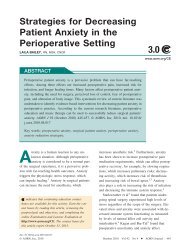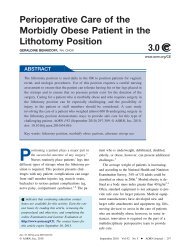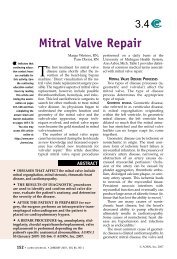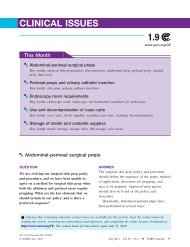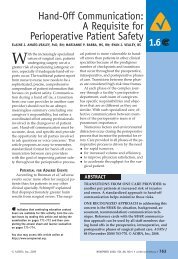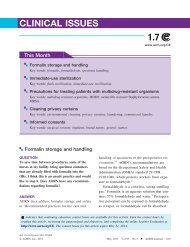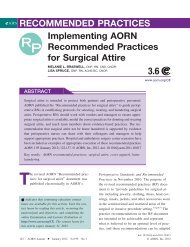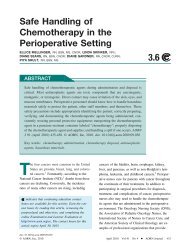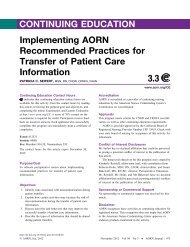JUNE 2009, VOL 89, NO 6Dobbenga-Rhodesstart directing her recovery; however, nursesshould not wait <strong>to</strong> implement these actions.These should be carried out alongside advancedcardiac life support pro<strong>to</strong>cols. Performing andproviding fundal (ie, uterine) massage can indicatethe degree of uterine a<strong>to</strong>ny and the patient’sresponse <strong>to</strong> therapy. Administration of oxy<strong>to</strong>cin,a medication familiar <strong>to</strong> obstetric nurses, will berequired. Programming of IV pumps for oxy<strong>to</strong>cinand the knowledge of its side effects ofwater in<strong>to</strong>xication from large infused volumes 53may be unfamiliar <strong>to</strong> critical care or perioperativenurses. Keeping the obstetric nurse involvedin the care of this patient after delivery, duringresuscitation, and while providing supportivecare allows the obstetric nurse <strong>to</strong> share his or herunique knowledge and expertise. A team approach<strong>to</strong> this lengthy—sometimes days-long—resuscitation effort will benefit the patient.Epidural catheters placed for labor analgesiashould remain in place until the patient has aplatelet count of at least 100,000 per millimeter. 5,54While on bed rest, pneumatic compression deviceswill help reduce the patient’s risk of otherthromboembolic events. 25 The ongoing task ofinspecting the patient’s episio<strong>to</strong>my may requirethat the obstetric nurse educate OR, PACU, andcritical care nurses about how best <strong>to</strong> performthis task. Continual moni<strong>to</strong>ring of postpartumblood loss can be done by weighing sanitarypads (1 g = 1 mL). Frequent patient care visits <strong>to</strong>the PACU and critical care unit (CCU) by obstetricnursing staff members will ensure appropriateevaluation of the patient for breastfeeding,routine breast pumping, or general breast care.Routinely scheduled application of a breastpump every four hours for 15 minutes also mayhelp with uterine involution and decrease theneed for long-term oxy<strong>to</strong>cin use.FAMILY SUPPORT. Unlimited family visitation inthe PACU and CCU is instrumental in the maternalpatient’s recovery, especially if the neo -nate is unable <strong>to</strong> visit or has died. Despiteneonatal outcome, facilitation of maternal-infantbonding should occur. This may mean havingsupport persons in the PACU and working withthe perinatal nursing staff members <strong>to</strong> safelytransfer the neonate for visitation. Pictures of thedeceased neonate or family viewing and holdingof the neonate’s body has been shown <strong>to</strong> aidKeeping the obstetric nurse involved inthe care of the patient after delivery,during resuscitation, and whileproviding supportive care allows theobstetric nurse <strong>to</strong> share his or herunique knowledge and expertise<strong>to</strong> benefit the patient.in grief resolution. 55 Viewing should be encouragedthroughout the patient’s hospitalization,and trips <strong>to</strong> the morgue <strong>to</strong> retrieve the neo nateshould be conducted with respect and modesty.Allowing unlimited viewing of the deceasedinfant as well as unsupervised family time withthe mother is helpful. Family members maywant <strong>to</strong> take pictures of the infant, mother, orboth, which may seem morbid <strong>to</strong> someone unfamiliarwith perinatal loss, yet families expressdeep gratitude for any memen<strong>to</strong> they have ofthis time. 55 The opportunity for such activitymay need <strong>to</strong> occur in the OR or PACU settingwhen there is little time or little hope of survivalof the maternal patient, the neonate, or both.Nursing staff members should anticipate a widerange of family members’ emotions, particularlyif the mother dies and the neonate survives. 33Many obstetric units have dedicated memoryboxes <strong>to</strong> hold copies of footprints, locks of hair,identification bands, receiving blankets, and pictures.Maternal patients and surviving familymembers may need counseling after such a traumaticevent. In some instances, the counselingmay include reproductive counseling for survivorswishing <strong>to</strong> undertake another pregnancy.Although this may seem daunting or ill-advised,there are six case reports of successful pregnanciesafter AFE with no recurrence. 56STAFF MEMBER SUPPORT. Care and support offered<strong>to</strong> patients and family members is a natural re-1086 • <strong>AORN</strong> JOURNAL
Dobbenga-Rhodes JUNE 2009, VOL 89, NO 6sponse, yet care and support also must be offered<strong>to</strong> the nursing and medical staff membersinvolved in this event. 57 Opportunities <strong>to</strong> debriefshould be provided as soon as possible after theevent and with as many personnel involved aspossible <strong>to</strong> make it effective and <strong>to</strong> allow staffmembers <strong>to</strong> generate a meaningful action planfor future AFE emergencies. The action planshould include an outline of specific responsibilitiesand locations of necessary equipment. Griefcounseling should be offered via pas<strong>to</strong>ral care orthrough employee assistance programs. 33 Initialand ongoing education of nurses about maternaland perinatal bereavement care is needed. Effectivestrategies for coping during and after providingcare <strong>to</strong> these families supports nurses inmeeting the emotional challenge of providinghigh-quality maternal and perinatal bereavementcare. 57CONCLUSION<strong>Responding</strong> <strong>to</strong> AFE is a team effort. Eachteam member brings his or her skill set and expertise.Supportive management of the maternalpatient experiencing this uncommon andunpredictable event is central <strong>to</strong> her survival,and the emotional support of team members iscrucial <strong>to</strong> ongoing quality patient care.REFERENCES1. Abenhaim HA, Azoulay L, Kramer MS, Leduc L.Incidence and risk fac<strong>to</strong>rs of amniotic fluid embo -lisms: a population-based study on 3 million births inthe United States. Am J Obstet Gynecol. 2008;199(1):49.e1-49.e8.2. Tuffnell DJ. United Kingdom amniotic fluid embolismregister. BJOG. 2005;112(12):1625-1629.3. Stafford I, Sheffield J. <strong>Amniotic</strong> fluid embolism.Obstet Gynecol Clin North Am. 2007;34(3):545-553, xii.4. Ma<strong>to</strong> J. Suspected amniotic fluid embolism followingamnio<strong>to</strong>my: a case report. AANA J. 2008;76(1):53-59.5. Meyer JR. Embolia pulmonar amnio-caseosa.Brasil Med. 1926;2:301-303.6. Steiner PE, Lushbaugh C. Maternal pulmonaryembolism by amniotic fluid as a cause of obstetricshock and unexpected deaths in obstetrics. JAMA.1941;117:1245-1254.7. Liban E, Raz S. A clinicopathologic study of fourteencases of amniotic fluid embolism. Am J ClinPathol. 1969;51(4):477-486.8. Masson RG. <strong>Amniotic</strong> fluid embolism. Clin ChestMed. 1992;13(4):657-665.9. Resnik R, Swartz WH, Plumer MH, BenirschkeK, Stratthaus ME. <strong>Amniotic</strong> fluid embolism withsurvival. Obstet Gynecol. 1976;47(3):295-298.10. O’Shea A, Eappen S. <strong>Amniotic</strong> fluid embolism.Int Anesthesiol Clin. 2007;45(1):17-28.11. Kramer MS, Rouleau J, Baskett TF, Joseph KS;Maternal Health Study Group of the CanadianPerinatal Surveillance System. <strong>Amniotic</strong>-fluid embolismand medical induction of labour: a retrospective,population-based cohort study. Lancet.2006;368(9545):1444-1448.12. Schoening AM. <strong>Amniotic</strong> fluid embolism: His<strong>to</strong>ricalperspectives and new possibilities. MCN AmJ Matern Child Nurs. 2006;31(2):78-83.13. Williams J, Mozurkewich E, Chilimigras J, Van deVen C. Critical care in obstetrics: pregnancy-specificconditions. Best Pract Res Clin Obstet Gynaecol. 2008;22(5):825-846.14. Grimes DA, Cates W Jr. Fatal amniotic fluid embolismduring induced abortion, 1972-1975. SouthMed J. 1977;70(11):1325-1326.15. De Jong MJ, Fausett MB. Anaphylac<strong>to</strong>id syndromeof pregnancy. A devastating complication requiring intensivecare. Crit Care Nurse. 2003;23(6):42-48.16. Malhotra P, Agarwal R, Awasthi A, DAS A, BeheraD. Delayed presentation of amniotic fluid embolism:lessons from a case diagnosed at au<strong>to</strong>psy.Respirology. 2007;12(1):148-150.17. Haines J, Wilkes RG. Non-fatal amniotic fluid embolismafter cervical suture removal. Br J Anaesth.2003;90(2):244-247.18. Fletcher SJ, Parr MJ. <strong>Amniotic</strong> fluid embolism: acase report and review. Resuscitation. 2000;43(2):141-146.19. Stehr SN, Liebich I, Kamin G, Koch T, Litz RJ.Closing the gap between decision and delivery—amniotic fluid embolism with severe cardiopulmonaryand haemostatic complications with agood outcome. Resuscitation. 2007;74(2):377-381.20. Moore J, Baldisseri MR. <strong>Amniotic</strong> fluid embolism.Crit Care Med. 2005;33(10 Suppl):S279-S285.21. Gilbert WM, Danielsen B. <strong>Amniotic</strong> fluid embolism:decreased mortality in a population-basedstudy. Obstet Gynecol. 1999;93(6):973-977.22. Wilhite L, Melander S. <strong>Amniotic</strong> fluid embolism:a case study. Am J Nurs. 2008;108(7):83-85.23. Ellingsen CL, Eggebø TM, Lexow K. <strong>Amniotic</strong>fluid embolism after blunt abdominal trauma.Resuscitation. 2007;75(1):180-183.24. MacDorman MF, Menacker F, Declercq E. Cesareanbirth in the United States: epidemiology, trends, andoutcomes. Clin Perina<strong>to</strong>l. 2008;35(2):293-307.25. Clark SL, Belfort MA, Dildy GA, Herbst MA,Meyers JA, Hankins GD. Maternal death in the 21stcentury: causes, prevention, and relationship <strong>to</strong>cesarean delivery. Am J Obstet Gynecol. 2008;199(1):36.e1-36.e5.26. Clark SL. New concepts of amniotic fluidembolism: a review. Obstet Gynecol Surv. 1990;45(6):360-368.27. Morgan M. <strong>Amniotic</strong> fluid embolism. Anaesthesia.1979;34(1):20-32.28. Green B, Umana E. <strong>Amniotic</strong> fluid embolism.<strong>AORN</strong> JOURNAL • 1087



